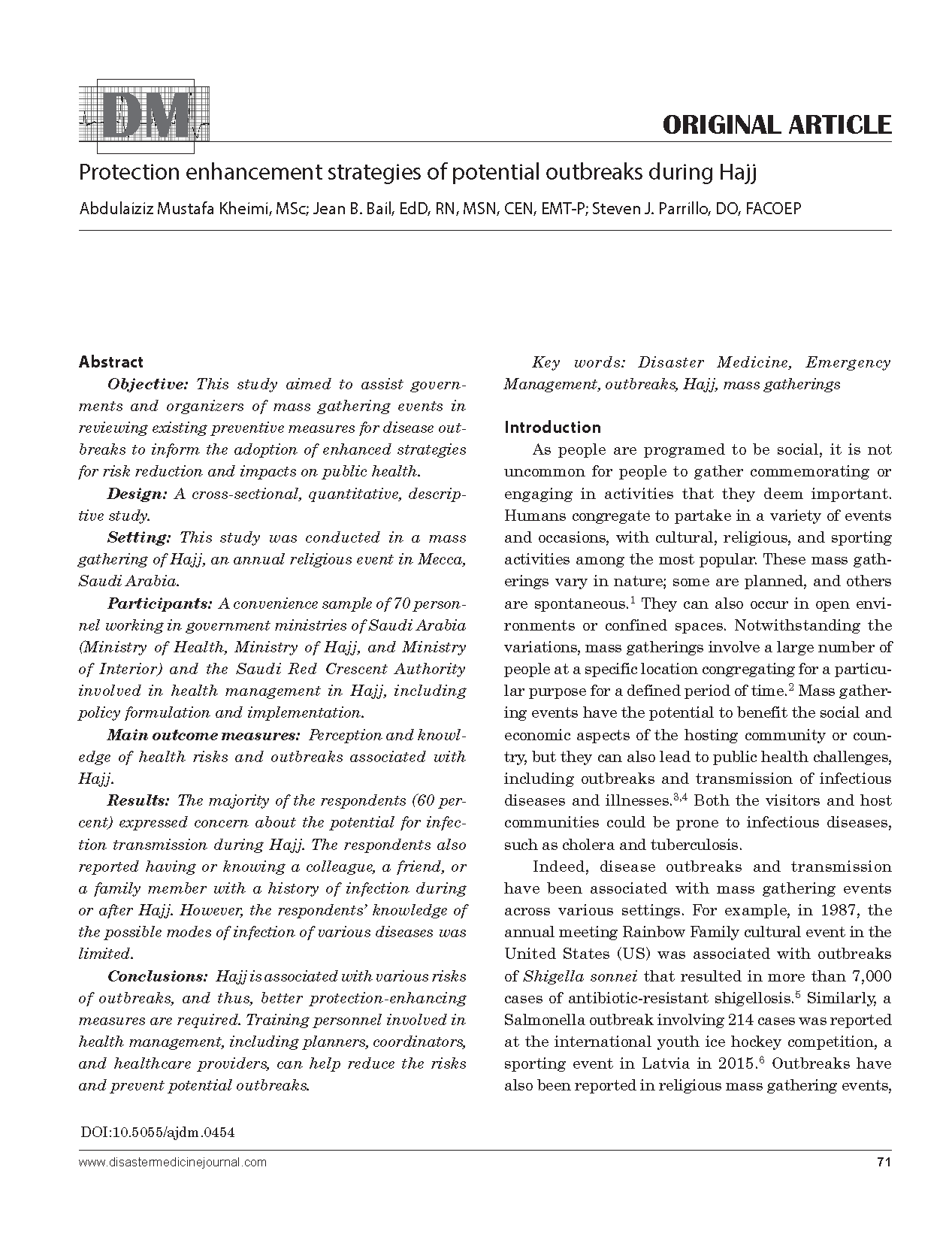Protection enhancement strategies of potential outbreaks during Hajj
DOI:
https://doi.org/10.5055/ajdm.0454Keywords:
Disaster Medicine, Emergency Management, outbreaks, Hajj, mass gatheringsAbstract
Objective: This study aimed to assist governments and organizers of mass gathering events in reviewing existing preventive measures for disease outbreaks to inform the adoption of enhanced strategies for risk reduction and impacts on public health.
Design: A cross-sectional, quantitative, descriptive study.
Setting: This study was conducted in a mass gathering of Hajj, an annual religious event in Mecca, Saudi Arabia.
Participants: A convenience sample of 70 personnel working in government ministries of Saudi Arabia (Ministry of Health, Ministry of Hajj, and Ministry of Interior) and the Saudi Red Crescent Authority involved in health management in Hajj, including policy formulation and implementation.
Main outcome measures: Perception and knowledge of health risks and outbreaks associated with Hajj.
Results: The majority of the respondents (60 percent) expressed concern about the potential for infection transmission during Hajj. The respondents also reported having or knowing a colleague, a friend, or a family member with a history of infection during or after Hajj. However, the respondents’ knowledge of the possible modes of infection of various diseases was limited.
Conclusions: Hajj is associated with various risks of outbreaks, and thus, better protection-enhancing measures are required. Training personnel involved in health management, including planners, coordinators, and healthcare providers, can help reduce the risks and prevent potential outbreaks.
References
Yezli S, Alotaibi BM: Mass gatherings and mass gatherings health. Saudi Med J. 2016; 37(7): 729-730. DOI: 10.15537/smj.2016.7.15419. DOI: https://doi.org/10.15537/smj.2016.7.15419
World Health Organization: Public health for mass gatherings: Key considerations. 2015. Available at https://iris.who.int/bitstream/handle/10665/162109/WHO_HSE_GCR_2015.5_eng.pdf?sequence=1. Accessed September 22, 2022.
Ahmed QA, Memish ZA: From the “madding crowd” to mass gatherings-religion, sport, culture and public health. Travel Med Infect Dis. 2019; 28: 91-97. DOI: 10.1016/j.tmaid.2018.06.001. DOI: https://doi.org/10.1016/j.tmaid.2018.06.001
Al-Tawfiq JA, Memish ZA: Mass gathering medicine: 2014 Hajj and Umra preparation as a leading example. Int J Infect Dis. 2014; 27: 26-31. DOI: 10.1016/j.ijid.2014.07.001. DOI: https://doi.org/10.1016/j.ijid.2014.07.001
Wharton M, Spiegel RA, Horan JM, et al.: A large outbreak of antibiotic-resistant shigellosis at a mass gathering. J Infect Dis. 1990; 162(6): 1324-1328. DOI: 10.1093/infdis/162.6.1324. DOI: https://doi.org/10.1093/infdis/162.6.1324
Pesola AK, Parn T, Huusko S, et al.: Multinational outbreak of Salmonella Enteritidis infection during an international youth ice hockey competition in Riga, Latvia, preliminary report, March and April 2015. Euro Surveill. 2015; 20(20): 21133. DOI: 10.2807/1560-7917.es2015.20.20.21133. DOI: https://doi.org/10.2807/1560-7917.ES2015.20.20.21133
Hassan S, Imtiaz R, Ikram N, et al.: Public health surveillance at a mass gathering: Urs of Baba Farid, Pakpattan district, Punjab, Pakistan, December 2010. East Mediterr Health J. 2013; 19(Suppl. 2): S24-S28.
Al-Lami F, Al-Fatlawi A, Bloland P, et al.: Pattern of morbidity and mortality in Karbala hospitals during Ashura mass gathering at Karbala, Iraq, 2010. East Mediterr Health J. 2013; 19(Suppl. 2): 13-18. DOI: https://doi.org/10.26719/2013.19.Supp2.S13
Youbi M, Dghoughi N, Akrim M, et al.: Preparedness and health risks associated with Moulay Abdellah Amghar Moussem, Morocco, 2009-2010. East Mediterr Health J. 2013; 19(Suppl. 2): 19-23. DOI: https://doi.org/10.26719/2013.19.Supp2.S19
Blyth CC, Foo H, van Hal SJ, et al.: Influenza outbreaks during world youth day 2008 mass gathering. Emerg Infect Dis. 2010; 16(5): 809-815. DOI: 10.3201/eid1605.091136. DOI: https://doi.org/10.3201/eid1605.091136
Parker AA, Staggs W, Dayan GH, et al.: Implications of a 2005 measles outbreak in Indiana for sustained elimination of measles in the United States. N Engl J Med. 2006; 355(5): 447-455. DOI: 10.1056/NEJMoa060775. DOI: https://doi.org/10.1056/NEJMoa060775
Pfaff G, Lohr D, Santibanez S, et al.: Spotlight on measles 2010: Measles outbreak among travellers returning from a mass gathering, Germany, September to October 2010. Euro Surveill. 2010; 15(50): 19750. DOI: https://doi.org/10.2807/ese.15.50.19750-en
Aldossari M, Aljoudi A, Celentano D: Health issues in the Hajj pilgrimage: A literature review. East Mediterr Health J. 2019; 25(10): 744-753. DOI: 10.26719/2019.25.10.744. DOI: https://doi.org/10.26719/2019.25.10.744
Gautret P, Steffen R: Communicable diseases as health risks at mass gatherings other than Hajj: What is the evidence? Int J Infect Dis. 2016; 47: 46-52. DOI: 10.1016/j.ijid.2016.03.007. DOI: https://doi.org/10.1016/j.ijid.2016.03.007
Salmon-Rousseau A, Piednoir E, Cattoir V, et al.: Hajj-associated infections. Med Mal Infect. 2016; 46(7): 346-354. DOI: 10.1016/j.medmal.2016.04.002. DOI: https://doi.org/10.1016/j.medmal.2016.04.002
Wilder-Smith A, Foo W, Earnest A, et al.: High risk of Mycobacterium tuberculosis infection during the Hajj pilgrimage. Trop Med Int Health. 2005; 10(4): 336-339. DOI: 10.1111/j.1365-3156.2005.01395.x. DOI: https://doi.org/10.1111/j.1365-3156.2005.01395.x
Wilder-Smith A, Goh KT, Barkham T, et al.: Hajj-associated outbreak strain of Neisseria meningitidis serogroup W135: Estimates of the attack rate in a defined population and the risk of invasive disease developing in carriers. Clin Infect Dis. 2003; 36(6): 679-683. DOI: 10.1086/367858. DOI: https://doi.org/10.1086/367858
Abd El Ghany M, Alsomali M, Almasri M, et al.: Enteric infections circulating during Hajj seasons, 2011–2013. Emerg Infect Dis. 2017; 23(10): 1640-1649. DOI: 10.3201/eid2310.161642. DOI: https://doi.org/10.3201/eid2310.161642
Rui J, Wang Q, Lv J, et al.: The transmission dynamics of Middle east respiratory syndrome coronavirus. Travel Med Infect Dis. 2022; 45: 102243. DOI: 10.1016/j.tmaid.2021.102243. DOI: https://doi.org/10.1016/j.tmaid.2021.102243
Memish ZA, Zumla A, Alhakeem RF, et al.: Hajj: Infectious disease surveillance and control. Lancet. 2014; 383(9934): 2073-2082. DOI: 10.1016/S0140-6736(14)60381-0. DOI: https://doi.org/10.1016/S0140-6736(14)60381-0
Shafi S, Dar O, Khan M, et al.: The annual Hajj pilgrimage-minimizing the risk of ill health in pilgrims from Europe and opportunity for driving the best prevention and health promotion guidelines. Int J Infect Dis. 2016; 47: 79-82. DOI: 10.1016/j.ijid.2016.06.013. DOI: https://doi.org/10.1016/j.ijid.2016.06.013
Alsahafi AJ, Cheng AC: Health care workers’ awareness and infection control practices about Ebola virus disease in Hajj 2015. J Infect Public Health. 2019; 12(5): 720-725. DOI: 10.1016/j.jiph.2019.03.022. DOI: https://doi.org/10.1016/j.jiph.2019.03.022
Al-Ghamdi AS, Kabbash IA: Awareness of healthcare workers regarding preventive measures of communicable diseases among Hajj pilgrims at the entry point in Western Saudi Arabia. Saudi Med J. 2011; 32(11): 1161-1167.

Published
How to Cite
Issue
Section
License
Copyright 2007-2025, Weston Medical Publishing, LLC and American Journal of Disaster Medicine. All Rights Reserved.

